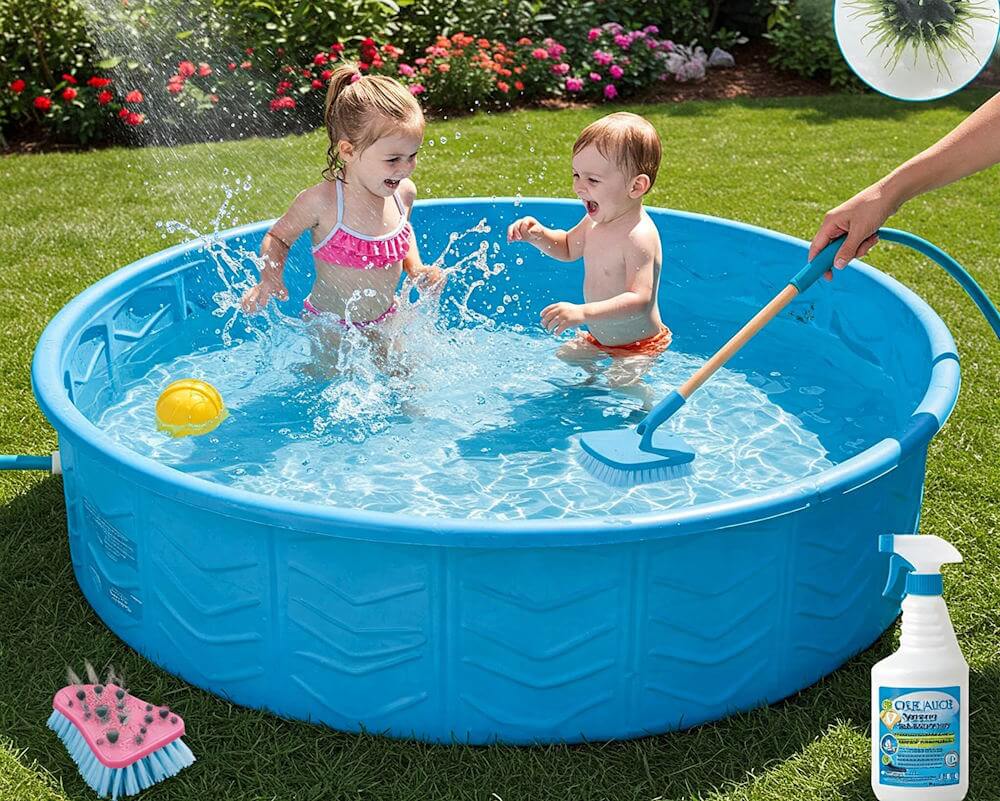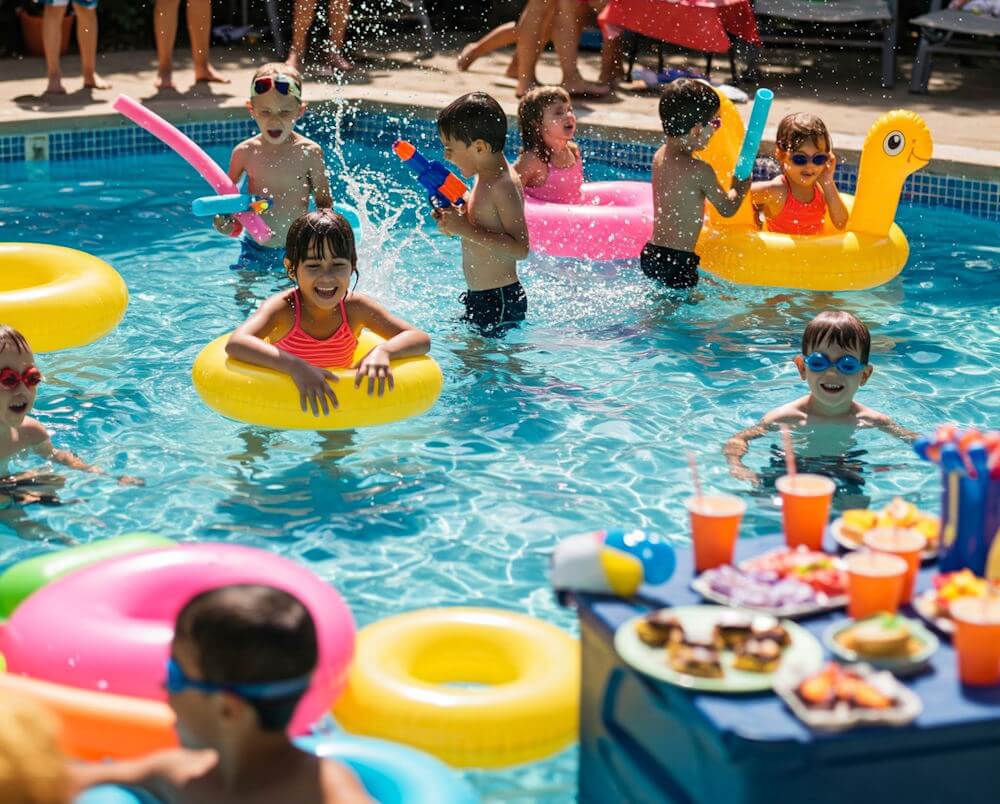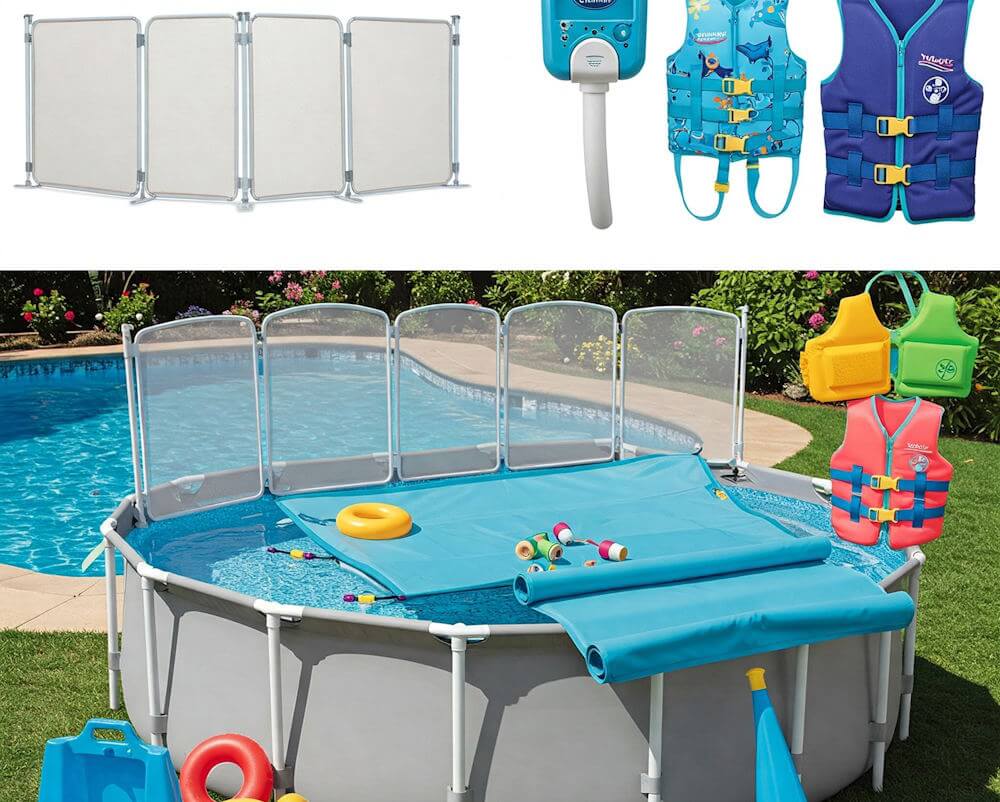Introduction to Kiddie Pools and Their Maintenance
Kiddie pools have gained immense popularity as an affordable and convenient way for families to provide their children with a safe and enjoyable swimming experience right in their own backyards. These smaller, shallow pools come in various shapes and sizes, making them accessible for infants to young children, and they are particularly favored during the warm summer months. However, while kiddie pools can offer countless hours of fun, they also require diligent maintenance to ensure safety and hygiene for those who use them.
One of the primary concerns surrounding kiddie pools is the rapid development of mold and mildew, especially when pools are not properly cared for. These fungi thrive in damp, warm environments, which are often created by stagnant water, particularly during hot weather. Beyond unpleasant smells and unsightly growths, mold and mildew can pose health risks not just to children but to the entire family. Therefore, understanding the importance of regular cleaning and maintenance is essential to prevent these issues effectively.
Proper maintenance involves several key practices, including frequent emptying and thorough cleaning of the pool. When not in use, it’s advisable to store the kiddie pool in a dry location to hinder mold and mildew growth. Likewise, parents and caregivers should routinely check the water quality, ensuring it remains clean and free from debris or organic matter. By integrating these preventive measures into their regular summer routines, families can significantly reduce the potential risk of mold and mildew, allowing children to enjoy their time in the pool without any health concerns associated with these fungi.
Understanding Mold and Mildew: What They Are and How They Grow
Mold and mildew are two types of fungi that thrive in moist environments, often leading to harmful consequences not only for surfaces but also for human health. While the terms are often used interchangeably, mold is typically characterized by its fuzzy appearance and can appear in a variety of colors, including green, black, and blue. Mildew, on the other hand, generally appears as a white or gray powdery substance, usually found on organic materials. Both mold and mildew reproduce by releasing spores into the air, which can easily spread to other areas, especially in humid conditions.
The growth of mold and mildew is facilitated by specific environmental conditions. They require moisture, warmth, and organic material to thrive. Kiddie pools, while a source of fun for children, often provide an ideal breeding ground for these fungi due to standing water, high humidity, and the presence of organic matter such as dirt and skin cells. When the water in a kiddie pool is not regularly changed or cleaned, it can quickly become stagnant, creating an environment conducive to mold and mildew development. Furthermore, if the pool is left uncovered, heat and humidity can create an even more favorable climate for fungal growth.
Identifying early signs of mold and mildew is crucial for prevention. Common indicators include discoloration on surfaces, musty odors, and visible fuzzy or powdery growth. Homeowners must remain vigilant, particularly after periods of rain or during hot weather when humidity levels are elevated. Being proactive about addressing these conditions can save time and resources while ensuring a safe and enjoyable swimming experience for children. Understanding the biology and environmental needs of mold and mildew will equip individuals with the knowledge necessary to maintain a clean and healthy kiddie pool.
The Dangers of Mold and Mildew in Kiddie Pools
The presence of mold and mildew in kiddie pools poses significant health risks, particularly for young children whose immune systems may still be developing. Mold spores can become airborne, leading to respiratory issues such as bronchitis, asthma attacks, and other allergic reactions. Children are particularly susceptible due to their smaller lung capacity and higher breathing rates, which can result in increased inhalation of these harmful spores. Symptoms may include coughing, sneezing, and difficulty breathing, highlighting the urgent need for parents and caregivers to maintain a clean swimming environment.
In addition to the health implications, mold and mildew can severely degrade the quality of pool water. These fungi thrive in warm, damp environments and can quickly proliferate in kiddie pools that are not regularly cleaned or treated. Contaminated water can lead to skin irritations and infections, further complicating the health risks associated with mold and mildew. Moreover, while adults may recognize these dangers, children may not immediately understand the risks, making vigilant oversight crucial.
Furthermore, mold and mildew can cause significant damage to the pool structure itself. Over time, these fungi can weaken the materials used in the pool’s construction, leading to costly repairs and maintenance issues. Regular cleaning and proper maintenance practices can help mitigate these issues, ensuring both the longevity of the pool and the safety of those who use it. By prioritizing cleanliness, parents can foster a safer swimming environment, protecting their children from the adverse effects associated with mold and mildew. Taking proactive measures not only supports the health of young swimmers but also enhances their enjoyment of outdoor activities in kiddie pools.
Key Preventative Measures for Mold and Mildew
Preventing mold and mildew in kiddie pools is essential for ensuring a safe and enjoyable environment for children. The first step in safeguarding against these unwanted growths involves selecting the right location for the pool. Ideally, choose an area that receives ample sunlight, as sunlight can help deter mold development by drying out any residual moisture. Avoid placing the kiddie pool under dense trees or near vegetation that may shed leaves or debris, which can introduce organic material conducive to mold growth.
Proper water chemistry also plays a crucial role in preventing mold and mildew. Regularly testing and balancing the water pH levels, along with maintaining appropriate sanitizer levels, significantly reduces the risk of microbial growth. It is recommended to keep the pH between 7.2 and 7.8 and to use chlorine or bromine to sanitize the water effectively. Additionally, ensure that water is replaced frequently as stagnant water is a breeding ground for mold and mildew.
Sun exposure practices are another vital aspect of prevention. When the kiddie pool is not in use, consider covering it with a tarp or pool cover to minimize exposure to dirt and debris. This not only helps keep the water clean but also limits the moisture in the air that contributes to mold growth. Furthermore, creating a routine cleaning schedule is vital to maintain pool hygiene. Regularly scrubbing the sides of the pool and the bottom, as well as disinfecting any toys or accessories, will help in eliminating any potential spores that are present.
By implementing these key strategies, parents and caregivers can proactively safeguard their kiddie pools, ensuring a safe, clean, and enjoyable experience for their children while greatly reducing the risk of mold and mildew. Maintaining vigilance in these areas will provide lasting protection and enhance pool enjoyment.
Cleaning Techniques for Kiddie Pools
Maintaining a clean kiddie pool is essential for the health and safety of children who use it. One of the most effective ways to prevent the growth of algae, mold, and mildew is through routine cleaning and deep cleaning techniques. For routine maintenance, it is advisable to clean the pool at least once a week. Begin by using a skimmer net to remove debris such as leaves, insects, and other foreign materials that may accumulate on the surface of the water. Following this, you can use a pool brush to scrub the walls and floor of the kiddie pool. This simple technique can dislodge any build-up of mold or algae that might be forming.
To enhance the cleaning process, use a mixture of water and white vinegar, which acts as a natural disinfectant. Combine one part vinegar with four parts water in a spray bottle and apply it to the affected areas. Allow it to sit for a few minutes before scrubbing with your brush. Rinse the pool thoroughly to ensure there are no residues of vinegar, as it may cause potential irritations to children’s skin.
For deeper cleaning, consider using baking soda, which effectively combats mildew and odors. Create a paste by mixing half a cup of baking soda with water and apply it generously to moldy spots. Let the paste sit for about 15 to 20 minutes, then scrub with a non-abrasive brush before rinsing. For those who prefer commercial options, look for eco-friendly pool cleaners that are specifically formulated to be non-toxic and safe for use around children. It is crucial to follow the manufacturer’s instructions carefully to maximize effectiveness while ensuring safety. These cleaning methods will contribute to a healthier swimming environment, allowing kids to enjoy their playtime without the worry of mold or mildew contamination.
Water Management: Importance of Proper Drainage and Filtration
Effective water management is crucial in maintaining a healthy and enjoyable kiddie pool environment. Proper drainage and filtration are essential measures in preventing the growth of mold and mildew, which thrive in stagnant and unclean water. Regularly draining and refilling the pool not only keeps the water fresh but also reduces the potential for harmful microorganisms to establish themselves. It is advisable to change the water frequently, especially after heavy use or after exposure to outdoor contaminants such as leaves, dirt, or pet dander.
The role of a filtration system cannot be overstated. If a kiddie pool is equipped with a filtration system, ensuring it is in good working condition is vital for water clarity and safety. Regular maintenance, including cleaning or replacing the filter as recommended by the manufacturer, helps remove debris and microorganisms from the water. Neglecting the filtration system can lead to murky water and create an environment where mold and mildew can thrive.
To further inhibit mold growth, it’s beneficial to incorporate additional practices in water management. One best practice is to check the pool’s water chemistry, particularly the pH and chlorine levels. Maintaining appropriate chemical balances not only helps sanitize the water but also enhances the comfort of swimmers. Using covers when the pool is not in use can also prevent debris accumulation, thus reducing organic matter that can serve as a breeding ground for mold.
Moreover, employing routine cleaning procedures, such as scrubbing the pool walls and bottom, will eliminate any existing mold spores before they become a significant issue. By prioritizing proper drainage and filtration, along with these supplementary practices, pool owners can effectively reduce the risk of mold and mildew development, creating a safer swimming environment for children.
Seasonal Considerations for Kiddie Pool Maintenance
The maintenance of kiddie pools is highly influenced by seasonal changes, which can significantly affect the risks of mold and mildew growth. Understanding these variations across different seasons is crucial to ensure a safe and enjoyable swimming environment for children. During the hotter months, particularly in summer, kiddie pools can become breeding grounds for mold if not properly maintained. The combination of heat, moisture, and organic material from children and the surrounding environment contributes to an ideal setting for mold spores to flourish.
To mitigate these risks in warm weather, regular cleaning is essential. This includes draining and rinsing the pool daily and scrubbing the sides with a non-toxic cleaner that can eliminate any potential mold. Additionally, parents should maintain water clarity and pH levels, as stagnant water is particularly susceptible to germs and mold. It is advisable to store the pool in a shaded area when not in use to minimize exposure to the sun, which can lead to algae and mold growth.
Contrarily, cooler months present a different set of challenges. With lower temperatures, water can remain stagnant for extended periods, leading to potential freezing and subsequent cracking of pool materials if not appropriately winterized. Families should ensure that the pool is thoroughly cleaned and dried before storage, as any residues of sand, dirt, or organic matter can foster mold growth during the off-season. It’s important to cover the kiddie pool securely to protect it from the elements while stored away. Furthermore, a thorough inspection of the pool for any damage or wear can prevent unexpected issues when returning to outdoor activities in warmer months.
In essence, adjusting maintenance strategies according to seasonal changes is vital for keeping kiddie pools safe and mold-free throughout the year. Each season has distinct implications for pool care that, when addressed correctly, can prevent the proliferation of mold and ensure a healthy swimming environment for children.
When to Seek Professional Help
While regular maintenance can mitigate mold and mildew growth in kiddie pools, there are certain situations where professional intervention becomes essential. Recognizing the signs of severe contamination is crucial for maintaining a safe play environment. Dark patches, slimy surfaces, or an unpleasant odor can indicate a significant mold presence. If such signs appear, it is wise to assess the situation carefully; even minor contamination can pose a risk, especially to young children with developing immune systems.
Health risks associated with mold exposure are well-documented. Prolonged contact can lead to respiratory issues, allergies, and skin irritations in both children and adults. If anyone using the pool exhibits symptoms like difficulty breathing or rashes, seeking immediate professional assistance is recommended. This ensures not only the safety of the children but also protects the integrity of the pool area.
In addition to health concerns, the expertise of professionals can greatly enhance the cleaning process. They are equipped with specialized tools and eco-friendly chemicals that are more effective than typical household cleaners. A thorough assessment by a mold remediation expert can identify hidden growth, preventing future outbreaks. Moreover, professionals can often offer ongoing maintenance services to regularly check the pool’s condition, thus ensuring the environment remains safe and enjoyable over time.
Ultimately, while routine cleaning and monitoring of kiddie pools are essential, certain circumstances warrant a professional touch. Understanding when to seek help not only safeguards the health of everyone who uses the pool but also prolongs the life of the pool itself. Ensuring that the kiddie pool remains free from harmful mold and mildew enhances the overall experience, allowing families to enjoy their outdoor fun with peace of mind.
Conclusion: Enjoying a Mold-Free Kiddie Pool Experience
Preventing mold and mildew in kiddie pools is crucial to ensuring a safe and enjoyable swimming environment for children. Mold and mildew can not only make a kiddie pool uninviting but also pose health risks to young swimmers. As such, understanding the significance of regular maintenance cannot be overstated. By taking proactive measures, parents can create a pleasant and hygienic space for their children to play.
Throughout this blog post, key strategies have been discussed that will help to mitigate the growth of mold and mildew. Regular cleaning routines, such as rinsing the pool after each use and disinfecting it weekly, play fundamental roles in maintaining water clarity and quality. Utilizing appropriate products that are effective against mold and mildew is fundamental in this endeavor, ensuring a safe chemistry that will not harm the children playing in the pool.
Moreover, proper water management practices, including maintaining appropriate water levels and pH, are essential in reducing the conditions that foster mold and mildew. Ensuring that the kiddie pool is drained and dried out when not in use limits moisture accumulation, which is a primary factor in mold growth. Parents should also consider placing the pool in a well-ventilated area, as sunlight can be a powerful ally in combating mildew. The collective application of these techniques will create a mold-free kiddie pool environment, providing reassurance for parents and an enjoyable experience for children.
By implementing the tips and recommendations discussed, families can effectively minimize the presence of mold and mildew in kiddie pools. This proactive approach not only ensures a cleaner swimming experience but also safeguards the health of their little ones, enabling them to enjoy summer days to the fullest.



